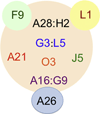Membrane fusion during poxvirus entry
- PMID: 27423915
- PMCID: PMC5161597
- DOI: 10.1016/j.semcdb.2016.07.015
Membrane fusion during poxvirus entry
Abstract
Poxviruses comprise a large family of enveloped DNA viruses that infect vertebrates and invertebrates. Poxviruses, unlike most DNA viruses, replicate in the cytoplasm and encode enzymes and other proteins that enable entry, gene expression, genome replication, virion assembly and resistance to host defenses. Entry of vaccinia virus, the prototype member of the family, can occur at the plasma membrane or following endocytosis. Whereas many viruses encode one or two proteins for attachment and membrane fusion, vaccinia virus encodes four proteins for attachment and eleven more for membrane fusion and core entry. The entry-fusion proteins are conserved in all poxviruses and form a complex, known as the Entry Fusion Complex (EFC), which is embedded in the membrane of the mature virion. An additional membrane that encloses the mature virion and is discarded prior to entry is present on an extracellular form of the virus. The EFC is held together by multiple interactions that depend on nine of the eleven proteins. The entry process can be divided into attachment, hemifusion and core entry. All eleven EFC proteins are required for core entry and at least eight for hemifusion. To mediate fusion the virus particle is activated by low pH, which removes one or more fusion repressors that interact with EFC components. Additional EFC-interacting fusion repressors insert into cell membranes and prevent secondary infection. The absence of detailed structural information, except for two attachment proteins and one EFC protein, is delaying efforts to determine the fusion mechanism.
Keywords: Endocytosis; Hemifusion; Membrane fusion; Vaccinia virus; Virus entry.
Published by Elsevier Ltd.
Figures




References
Publication types
MeSH terms
Substances
Grants and funding
LinkOut - more resources
Full Text Sources
Other Literature Sources

